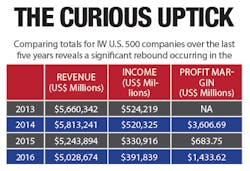Here we are now, nine years into the recovery from the Great Recession, a year and a half into a new business-minded presidency, and currently in the wild midst of a digital transformation rocking the entire manufacturing sector.
In many ways, this is probably one of the most exciting, turbulent, and opportunity-rich times manufacturing has seen since the end of World War II. At the heart of it is a movement matching two equal-but-opposite forces simultaneously stymieing and bolstering the industry.
On one side, we have innumerable headwinds ranging from skilled worker shortages to long overdue capital investments and digital overhauls, complicated further by new tariff threats, looming trade wars, and governmental uncertainty clouding everything.
On the other side, we have an economy far healthier than any of us could have possibly imagined a decade ago when the auto industry was on life support and needed a government bailout. Now the Big 3, and the rest of U.S. manufacturing, is supplemented by a tax overhaul designed to prop up American businesses plus a deregulation streak intended to accelerate growth and investment.
All that is missing now is a clear scoring of which side of this is winning—an objective account of how manufacturing is really faring in all of this. In this sense, the 2018 IW U.S. 500 couldn't have come at a better time.
Crunching the Numbers
The IW U.S. 500 has become a kind of annual manufacturing Big Data expedition. On the surface, the list is simply a ranking of the largest and most profitable U.S.-based public manufacturers across 30 different industries. But the data go much deeper than that.
The data set we use to build these lists extends to 126 fields, measuring everything from half a decade's worth of financial performance totals, to inventory turnovers, assets, and share prices for every American manufacturing company that pulled in more than $1.17 billion in the past year.
Our job has been to dig deep into this data to find the story of manufacturing—the ups and downs, the multiyear trends, the top companies, the waning industries.
Traditionally, given the make-up of American manufacturing, this has resulted in a kind of love song to big oil. And, indeed, that industry is once again the dominant force in this year's list. It claims 53 positions on the 2018 IW U.S. 500—including the top spot for Exxon Mobil Corp.—and a bit over 18% of the total revenue earned by all the companies on the list. Furthermore, of the 10 fastest rising companies represented in this year's ranking, six fall in the petroleum and coal industry.
This is a great story—it's good for jobs and the economy, for independence and U.S. manufacturing as a whole. Which is why we tend to tell it every year.
But, given the state of our economy and the forces at play in the manufacturing industry, there's a new story to tell. This year, we have explored this mighty data trove with one objective: to determine the true state of American manufacturing. And we have found that story in clear terms—the state of manufacturing is strong. Very, very strong... for now.
The Mysterious Uptick
Comparing the IW U.S. 500 data for the past five years reveals a curious pattern that most manufacturers have almost certainly felt, but which has rarely been made explicit in reports like this.
It starts with a couple of absolutely solid years. In 2013, the total revenue recorded for all 500 of these manufacturers came to $5.66 trillion, and in 2014 that figure swelled up to $5.81 trillion. Similarly, the companies recorded $524 billion in income in 2013, and just slightly under that at $520 billion the following year.
And then something weird happened.
In 2015, revenue suddenly fell by $600 billion while income took a $189 billion hit—a 36% decline in all. And in 2016, while income rebounded slightly, revenue tumbled an additional $200 billion.
Then, just as suddenly, everything snapped back.
Last year's totals put revenue back up to a healthy $5.42 trillion and income at $440 billion (a 31% rise from 2015).
Looking at these numbers, the conclusion seems clear: 2017 was a very good year for manufacturers, and even better for the relief it offered from a two-year slump.
The question now is why it was such a good year? And how long it will last?
Turning to the Experts
To answer this, we turned to Chris Kuehl, economic analyst for the Fabricators & Manufacturers Association (FMA).
Kuehl wasn't quite as surprised by the 2015-2016 dip as we were.
"We had some scrambling in the industry starting around 2014 and into 2015," he says. "I blame it on this weird, long, unsatisfactory recovery from the recession. Companies kept waiting for a real turnaround, delaying investments and hiring until their machines were wearing out."
This created a desperate state for many manufacturers, he says, which was compounded by lack of access to capital for those companies eager to rebuild.
"People forgot how complicated the Bank Reform Act was," he says. "The small and midsized banks that were the bread and butter for manufacturers weren't ready [to lend], so there just wasn't much money flowing for a while."
That changed, he argues, just as the data began to register the uptick.
"By the end of the [President] Obama years, money started to flow again and those banks started to lend," he says. And manufacturers all had machines to buy, technologies to adopt.
The second factor, he says, can also be directed at political considerations.
"We saw a certain amount of anticipatory enthusiasm driving accelerated growth," he says. "There was an expectation that, since we had a GOP in control of all that matters, there is surely going to be a tax cut and they are surely going to do something about regulations."
In this sense, he says, the sudden rebound in 2017 was a combination of two distinct factors: "It was President Obama and the Federal Reserve he created sticking to their guns, and it was the anticipation of traditional GOP policy toward business," Kuehl says.
The combined result of the two administrations, he argues, was a kind of low-scale investment frenzy through the market that is already paying off big on bottom lines.
Looking Forward
All of this puts the American manufacturing industry in a very good state. With growing investments in equipment, along with the policy changes industry leaders were banking on already in effect, 2018 is positioned to be an extraordinary year for manufacturing. This analysis is echoed by Krzysztof Bledowski, council director and senior economist with the Manufacturers Alliance for Productivity and Innovation (MAPI).
"The global economy was only beginning to move in synch [over the] last two years and only now are all parts of the world humming along nicely. That would explain the current upswing," he said in an email. "From my contacts with captains of industry (on the large side), everyone is beaming about good business conditions, full order books, and tight supply chains."
Beyond this short-term growth, however, Kuehl sees trouble brewing.
"What worries me going forward is that by the end of this year and early next, we're going to be sitting on some pretty hellacious inflation numbers," he says.
He points to two factors behind this worry. The first, not surprisingly, is the projected effects of tariffs and trade wars.
"If they carry on as they have, they are really going to take a chunk out of growth in certain sectors," he says. "In fact, we know they already have."
And the other, he says, might be the result of the very same tax overhaul that is currently propping up investment and growth.
"Tax cuts, as cool as they were, were really late," he says. "You do tax cuts in the middle of a recession to goose things up. Goosing the economy when it's already growing at 3% is asking for inflation—and we're being granted our wish."
While our data reflects a high-water mark for manufacturing, Bledowski forecasts a perfect storm of disappointment brewing from the opposing forces swirling overhead.
"I think people will look back on 2017 and 2018 saying, 'Those are the good old days, before you had to take out a loan to go to Applebee's.'"
This is one possible outcome, sure, but economists are famous for dire predictions. Kuehl himself prefaced his comments with that old joke, "we're famous for predicting 17 of the last three recessions."
We believe data empowers business decisions just as it does operations, and in this time when predictive analytics are all the rage, we think the numbers shouldn't induce fear, but action. Making wise decisions based off historical data and the economy's cyclical nature, and not falling into a spendthrift mania due to a few good years, could be the difference between eating at Applebee's and your favorite Michelin-starred restaurant.
Browse the full IndustryWeek U.S. 500 ranking.






